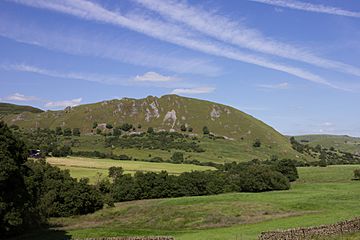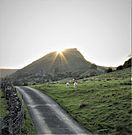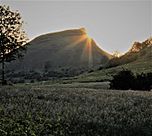Chrome Hill facts for kids
Quick facts for kids Chrome Hill |
|
|---|---|

Chrome Hill viewed from the southwest
|
|
| Highest point | |
| Elevation | c. 425 m (c. 1394 ft) |
| Geography | |
| Location | Peak District, England |
| OS grid | SK070673 |
| Topo map | OS Landranger 119 |
Chrome Hill is a special kind of hill in Derbyshire, England. It's found in the beautiful Peak District area. This hill is next to another similar hill called Parkhouse Hill.
Chrome Hill is known as a limestone reef knoll. This means it's a hill made from limestone that formed a long, long time ago. It was once part of an ancient coral reef under the sea!
Contents
Exploring Chrome Hill
Chrome Hill is a great place to visit and explore. It is open for everyone to enjoy. This was made possible by a law called the Countryside and Rights of Way Act 2000.
Walking Paths
Even though most of the hill is open, the path from the northwest side is a special "concessionary footpath." This means the landowner has given permission for people to use it.
Amazing Fossils
When you visit Chrome Hill, you might see some cool fossils. The hill has many clear examples of Gigantoproductus fossils. These are fossils of ancient sea creatures.
Chrome Hill is part of a special area called a Site of Special Scientific Interest (SSSI). This means it's protected because of its important geology and wildlife. Because it's an SSSI, it's against the law to take any rocks or fossils from the hill. This helps protect the site for everyone to see and learn from.
The Double Sunset Mystery
Chrome Hill is famous for a unique event called the "double sunset." This amazing sight happens only at a certain time of year.
How it Was Discovered
In 1997, a writer named Jeff Kent found out about this special sunset. He noticed that the sun seemed to set twice when viewed from Parkhouse Hill. Two years later, he found an even better spot to see it. This new spot was near Glutton Bridge, which is easier to get to.
Watching the Double Sunset
The double sunset can be seen from Glutton Bridge around the middle of summer. This is when the sun sets in the southwest, just behind Chrome Hill. But then, it quickly pops back up! It reappears from the hill's steep side. After a few minutes, the sun sets for a second and final time at the bottom of the hill. It's a really cool trick of nature! Jeff Kent wrote all about this event in his book, The Mysterious Double Sunset.
Chrome Hill in Music
Chrome Hill has even inspired musicians! Two Norwegian artists have written songs about this special hill.
- Sigurd Hole wrote a song simply called Chrome Hill.
- Jonas Howden Sjøvaag created a song titled Up on Chrome Hill.
In 2008, a Norwegian jazz band called Damp liked the hill so much, they changed their name to Chrome Hill!



